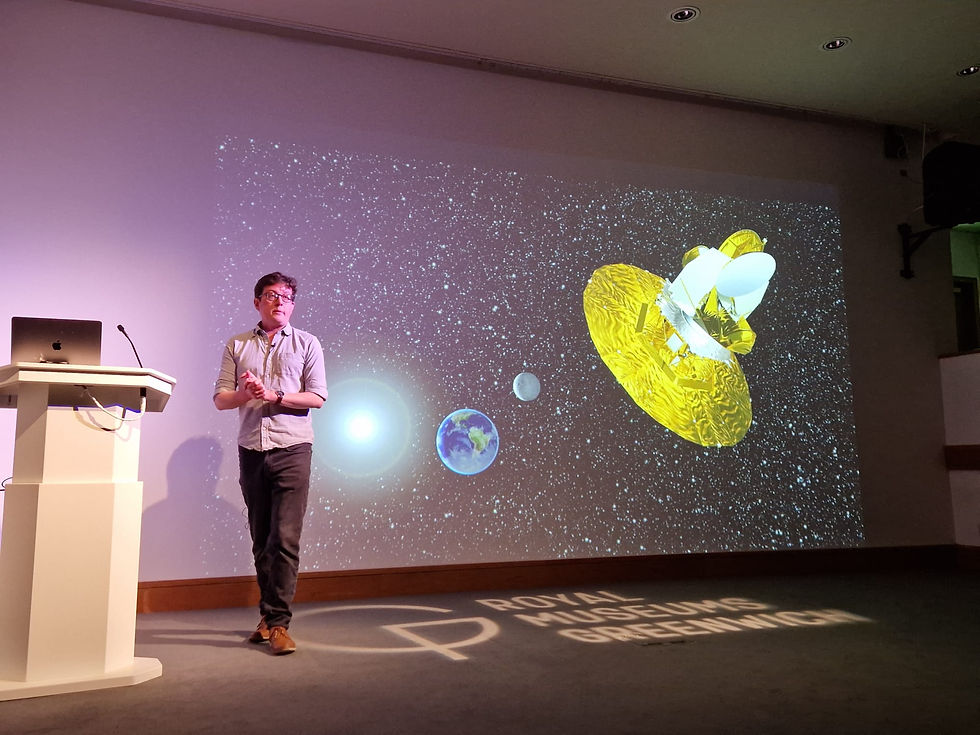How fast is the Universe expanding? by Dr Matt Bothwell
- Mike Meynell
- Mar 13, 2023
- 3 min read
Updated: Mar 17, 2023
Dr Matt Bothwell from the University of Cambridge started his fascinating talk with an apology to the audience... he was not going to be able to answer the question in the title of his talk! It's fair to say that our audience didn't seem to mind, as Matt took us on a journey through the history of the theory of an expanding universe, and highlighted the current disagreement in the measurement and what this might mean for the future of physics.
Matt started with "The Great Debate" between the astronomers Harlow Shapley and Heber Curtis in 1920, which took place in front of a paying audience. Shapley argued that the Milky Way was the entire Universe (the conventional idea at the time), whereas Curtis argued that the Milky Way was just one galaxy among many. The audience was apparently divided 50/50 on the outcome of the debate, but, within just a few years, it was clear that Curtis was completely correct, as Edwin Hubble proved that the "nebulae" were millions of light years away and therefore could not be within our Milky Way.

A very clear explanation of Hubble's law followed, and how we use the "Cosmic Distance Ladder" to get to a point where we can estimate distances to galaxies that are billions of light years away.
Hubble's law is described by the equation v = H0d, with H0 known as the Hubble constant. Hubble's first measurement of this constant was ~500 km/s/Mpc, which everyone knew was wrong at the time, as it meant that the Universe could be not be more than a billion years old.
The problem lay in the distance ladder, as distance measures using Cepheid variables turned out to be incorrect. Since the 1960s, we've known that the Hubble constant must lie in the range 50-100 km/s/Mpc. In the late 1990s, research based on observations from the Hubble Space Telescope converged on a value of around 70 km/s/Mpc.

Matt then went on to describe a different way of measuring the Hubble constant, based on measurements of Cosmic Microwave Background (CMB) radiation, much of the data coming from the Planck satellite, launched in 2009. When this research was originally performed, the measurements of the Hubble constant based on nearby galaxies and those based on measurements from the CMB were remarkably consistent. However, as more data was received, the more the data diverged, so that the Planck results now show a measurement of 67±0.6 km/s/Mpc whereas those based on nearby galaxies give 73±1.0 km/s/Mpc.

So, how to reconcile the difference? Matt asked the obvious question; is there a 'crisis' in cosmology? There are two potential solutions; either we are seeing evidence of new physics; or a mistake has been made somewhere. The answer is, unfortunately, "we don't know".
A lively Q&A followed, and it was obvious that the Flamsteed audience had been enthralled by Matt's talk.
At the end of the evening, several Flamsteed members purchased copies of Matt's book "The Invisible Universe: Why There’s More to Reality than Meets the Eye", which Matt kindly agreed to sign.
Our sincere thanks to Dr Matt Bothwell for making the trip from Cambridge to come and speak to the society.
Flamsteed members who missed the live event, or those who would like to see it again, can find a recording of the talk here (password supplied to members via email):
Photos from the evening by Bobby Manoo and Mike Meynell.














Comments